Adenovirus infections, 2008 to 2020, Japan
Human mastadenoviruses (Ad), which belong to the genus Mastadenovirus in the family Adenoviridae, are non-enveloped double-stranded DNA viruses that are relatively physicochemically stable. Ads are currently grouped into seven species from A to G and over 80 types have been described (as an example, type 3 is denoted as Ad3). Ads have been reported as serotypes up to Ad51, but those classified after Ad52 have been reported as genotypes based on whole genome sequencing.
Ad infection is associated with respiratory diseases, such as ARI (acute respiratory infections), ocular diseases, such as EKC (epidemic keratoconjunctivitis), and gastrointestinal diseases such as infectious gastroenteritis. Ads are also associated with urological diseases, such as hemorrhagic cystitis and urethritis, along with hepatitis (Table 1 and Table 2). The epidemic trajectory and inflammatory response vary depending on the Ad species (Nakamura et al.: JMV2018).
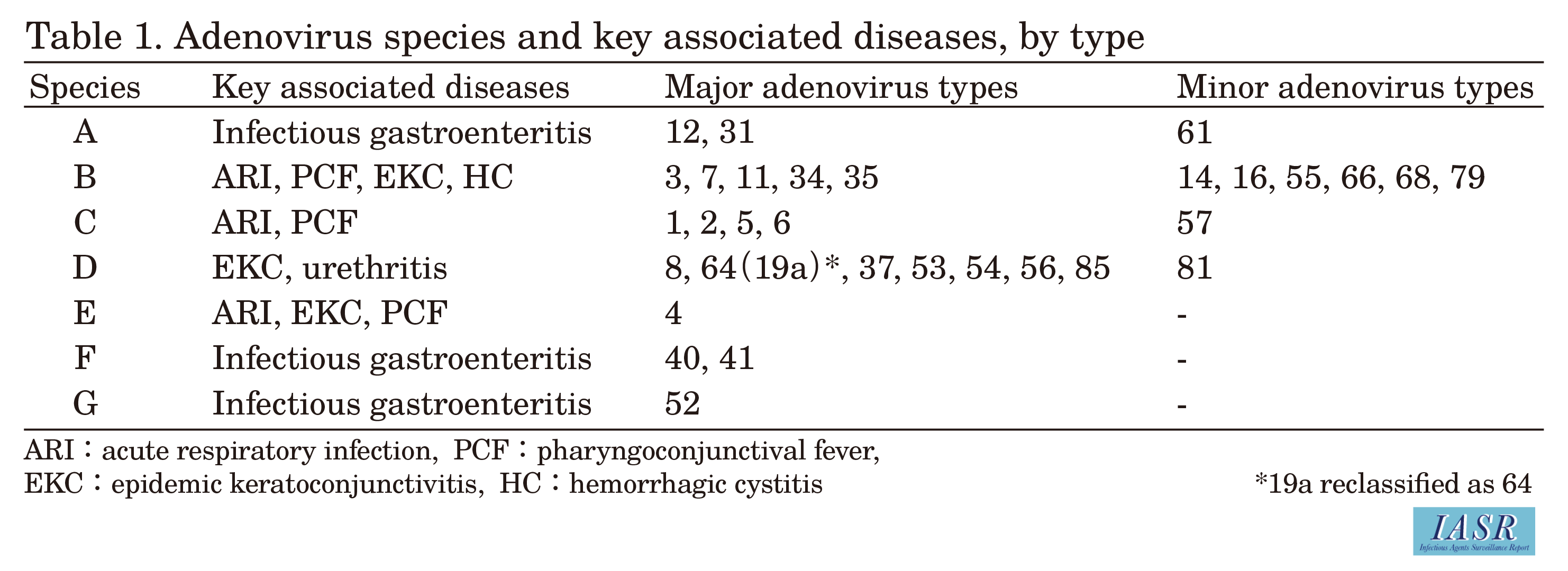 |
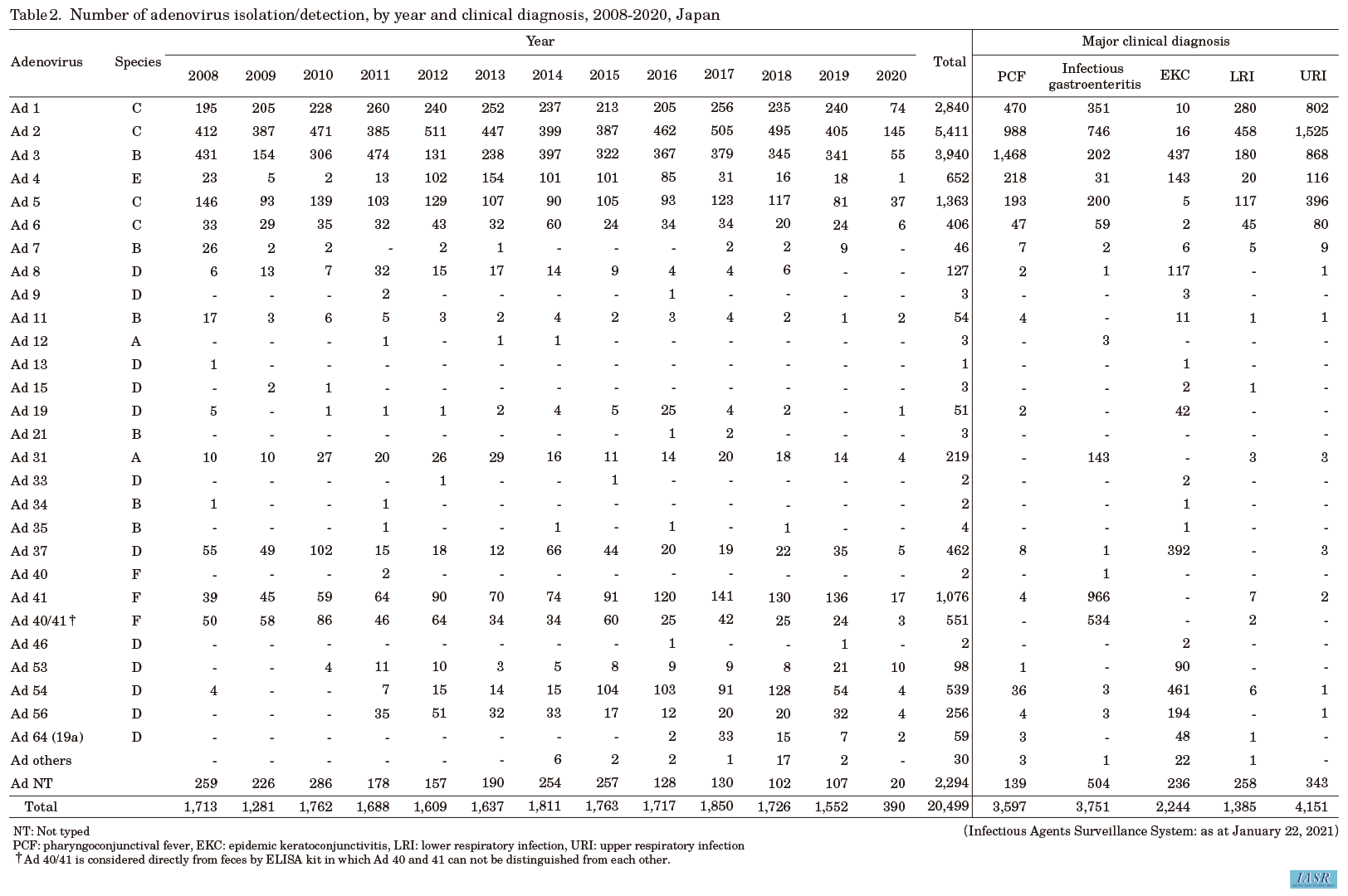 |
Ad infections are monitored under the National Epidemiological Surveillance of Infectious Diseases (NESID) system, specifically via sentinel surveillance for pharyngoconjunctival fever (PCF) and infectious gastroenteritis at approximately 3,000 pediatric sentinel sites nationwide and for EKC at approximately 700 ophthalmology sentinel sites nationwide (for notification criteria, see https://www.mhlw.go.jp/bunya/kenkou/kekkaku-kansenshou11/01-05-16.html, https://www.mhlw.go.jp/bunya/kenkou/kekkaku-kansenshou11/01-05-30.html). The notification criteria for EKC were revised in April 2020 and the pathogenic virus was defined as Ad, with more detailed aspects included in the definition (see p.71 of this issue). Laboratory-based surveillance is also being performed (see p.72 of this issue).
Reported cases of PCF and EKC: Since reporting of PCF cases at pediatric sentinel sites began in 1987, the largest number of PCF cases was reported in 2006 (Fig. 1, top). Although a summer peak in notifications has been consistently observed, an additional peak in winter has also been observed since 2003 (https://www.niid.go.jp/niid/en/10/2096-weeklygraph/1645-02pcf.html, https://nesid4g.mhlw.go.jp/Byogentai/Pdf/data27e.pdf). In 2020, during the coronavirus disease 2019 (COVID-19) epidemic, summer and winter peaks were also observed, although they were low (Fig. 1, top). Among PCF patients, children one year of age are reported in large numbers (Fig. 2, top).
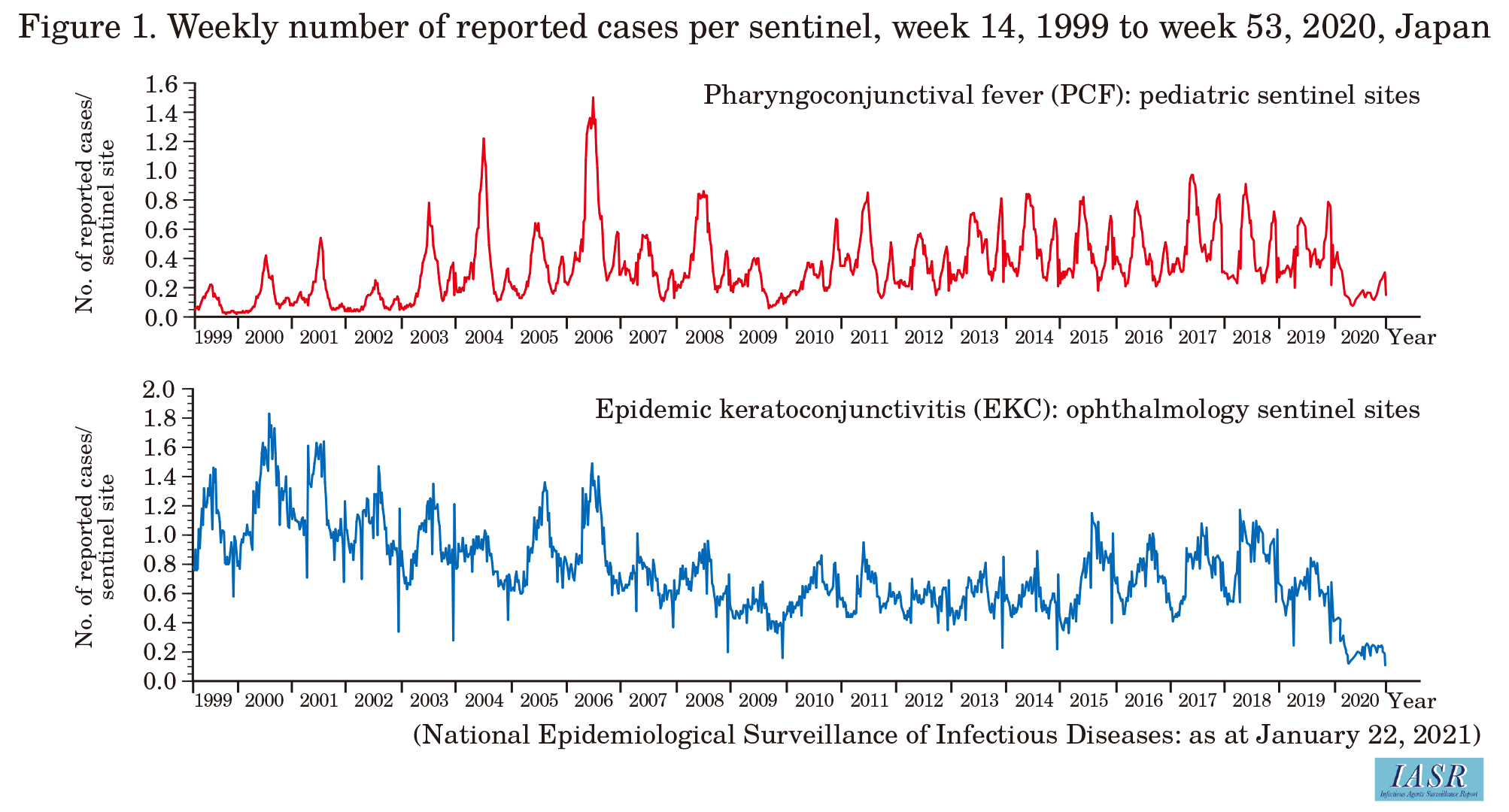 |
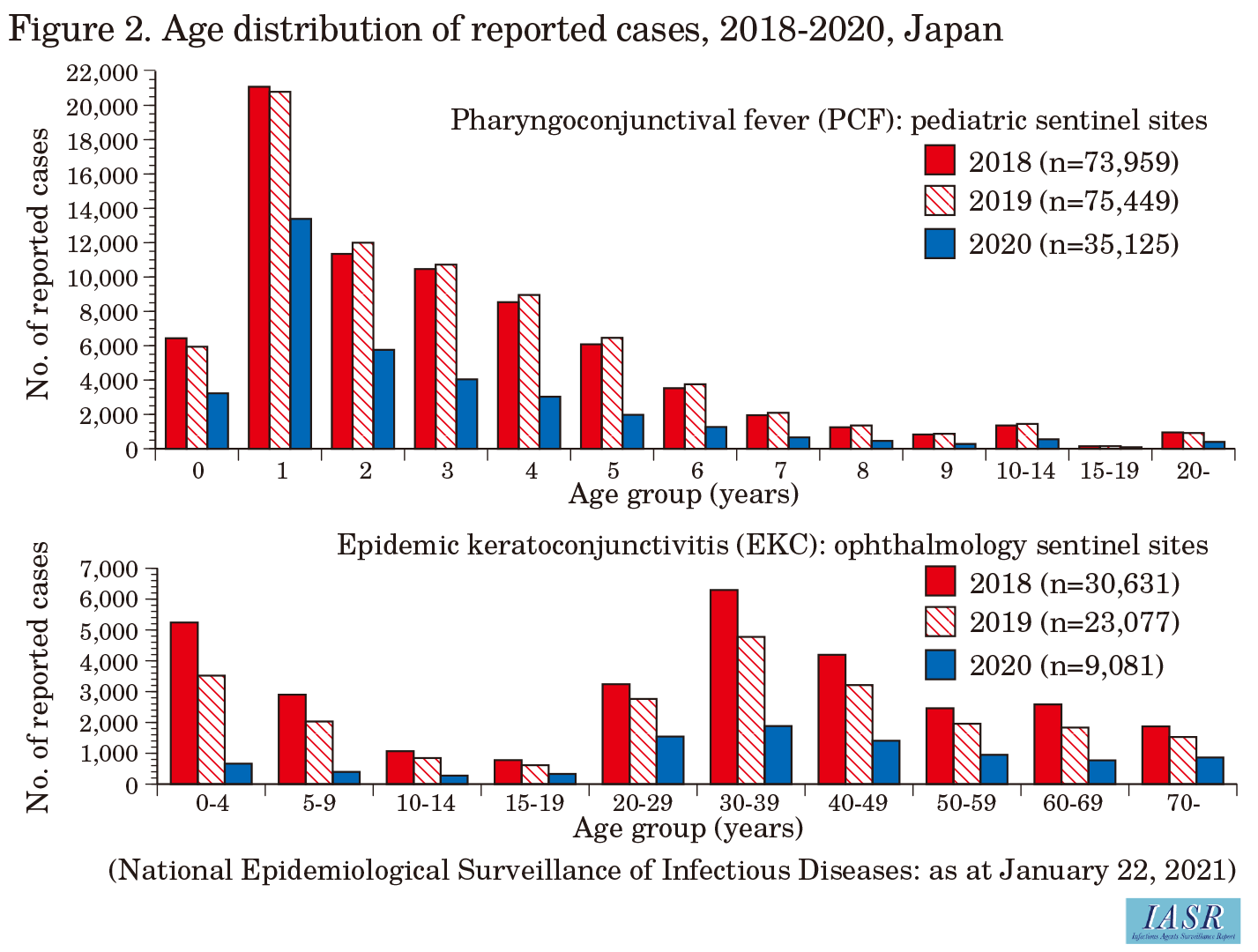 |
In contrast, EKC patients monitored at ophthalmology sentinel sites have been reported most frequently during May-August. Since 2015, however, notifications increased through autumn (Fig. 1, bottom and https://www.niid.go.jp/niid/ja/10/2096-weeklygraph/1656-15ekc.html). EKC patients are children, mainly among those aged 0-4 years, and adults across a wide age range, mainly in their 30s (Fig. 2, bottom).
According to an analysis using data from the National Database of Health Insurance Claims and Specific Health Checkups of Japan, the number of PCF and EKC patients in Japan during 2012-2016 was approximately 100,000 and 500,000-750,000 per year, respectively (see p.73 of this issue).
Isolation/detection of Ad: From 2008 to 2020, prefectural and municipal public health institutes (PHIs) reported 20,499 cases of the isolation/detection of Ad (Table 2), with Ad2 being the most frequent (26%), followed by Ad3 (19%) and Ad1 (14%).
The number of Ad isolation/detection reports from PCF patients was 3,597, with Ad3, Ad2, Ad1, Ad4, and Ad5 being frequent (Table 2).
From EKC patients, a total of 2,244 cases of Ad isolation/detection were reported; species D Ads, including Ad54, Ad37, Ad8, Ad53, and Ad64 (19a), were frequently reported (Table 2). Ad85 found in Japan is also the cause of EKC (Kaneko: JJID2020). In addition, Ad3 of species B and Ad4 of species E were reported from EKC patients (Fig. 3 and Table 2). In 2020, the notification criteria for EKC in NESID were revised, and EKC was defined as being caused by species D Ads.
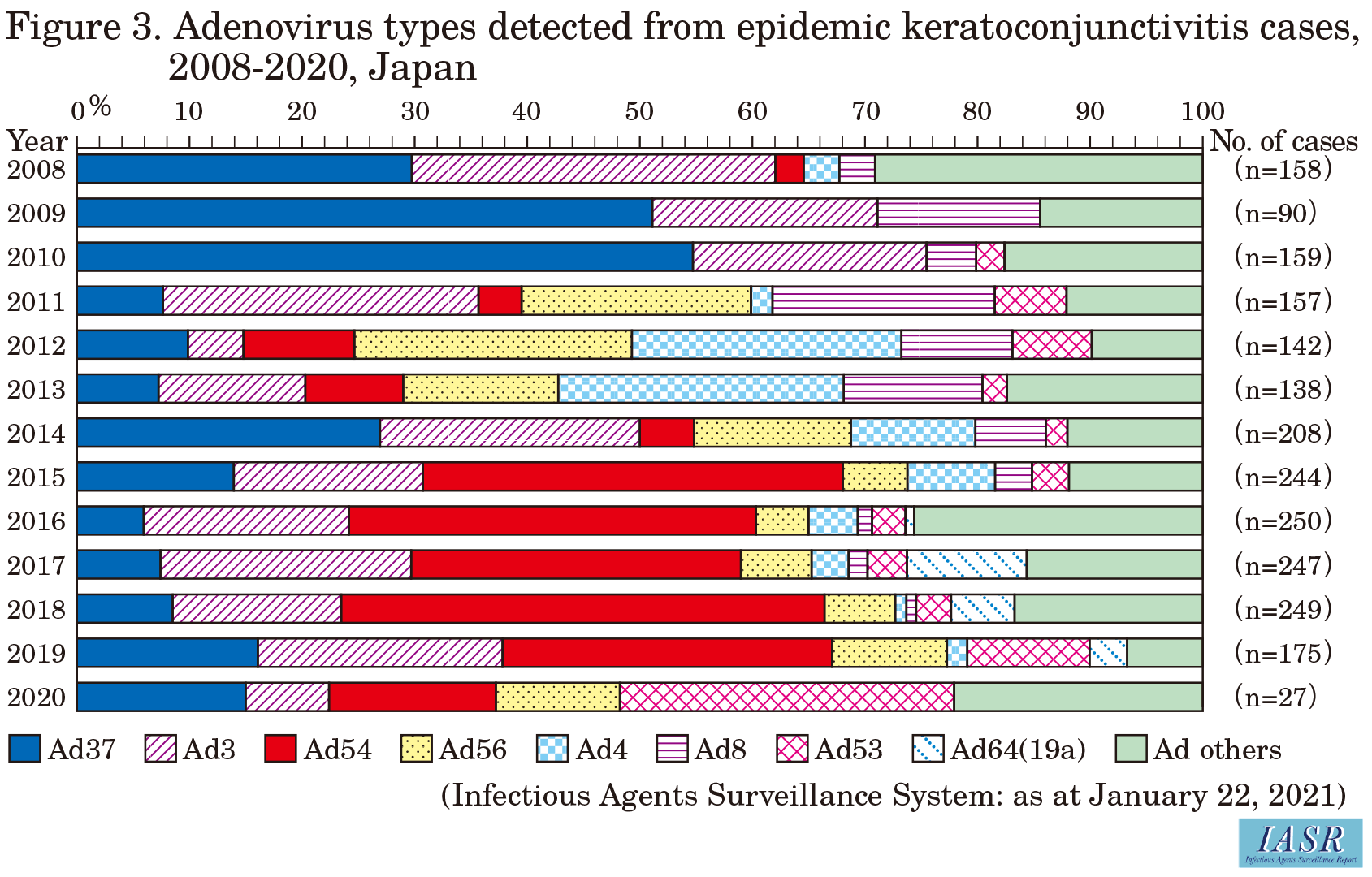 |
In other countries, Ad8 is the major pathogen of EKC, but in Japan, the frequency of Ad8 detection has decreased, whereas that of Ad54 detection has increased in recent years (Table 2).
The number of Ad reports from patients with infectious gastroenteritis was 3,751 and the main pathogen was species F (Ad40 or 41) (Table 2). There were also 143 detections of Ad31 belonging to species A (see p.75 of this issue).
Ad7 belonging to species B is known to cause severe pneumonia. During 1995-1998, when Ad7 was circulating at a high level, 863 cases of Ad7 detection were reported (https://www.niid.go.jp/niid/images/iasr/table/virus/adv91-00.pdf) and several fatal cases of Ad7 infection were also reported (IASR 17: 99-100, 1996 & 18: 79-80, 1997). During 2008-2020, 46 cases of Ad7 detection were reported (Table 2); continued careful monitoring of Ad7 is warranted (see p.76 of this issue).
Laboratory diagnostic methods: Although the lateral flow test to detect Ad antigen (IC-kit) cannot discriminate Ad types, it has the advantage of providing rapid results in the clinical setting. In Japan, approximately 2,700,000 kits are utilized annually, and with improvements, the sensitivity has been increasing.
Currently, typing has shifted from serotyping to genotyping. For routine laboratory testing at PHIs, partial sequencing of the penton base, hexon, and fiber regions is carried out (Laboratory manual for the diagnosis of PCF and EKC, ed. 3, https://www.niid.go.jp/niid/images/lab-manual/adeno_v3.pdf). As adenoviruses frequently undergo recombination among different types within a species, sequencing of multiple regions is necessary (see p.78 of this issue).
Therapy and prevention: Currently, there are no specific antiviral agents available in Japan that can be used to treat Ad infection. It is important to strengthen activities, such as the development of therapeutics against Ad infection, because it can be fatal in immunosuppressed patients after organ transplantation (see p.70 of this issue).
As Ad is transmitted via contact or droplets, hand hygiene is important for infection prevention. However, standard alcohol-based disinfectants are ineffective and utilization of an effective disinfectant is important (see p.75 of this issue). In particular, as the eye discharge and tears of infected patients contain large amounts of Ad, it is important in ophthalmology to detect infected patients early and reduce further transmission through patient interviews and diagnostic kits in accordance with the guidelines for ophthalmologists (https://www.nichigan.or.jp/member/journal/guideline/detail.html?ItemId=283&dispmid=909). For children, hygiene management should be implemented following the School Health and Safety Act and the Infection Control Guidelines in Nurseries (http://www.mhlw.go.jp/stf/seisakunitsuite/bunya/0000123472.html) to target the source of infection, route of transmission, and susceptibility (the three major factors for the establishment of infection).
Although Ad is often regarded as a mild pediatric infectious disease, it can cause a wide range of diseases depending on the species and type. Furthermore, as it can be severe, infection control is important.

